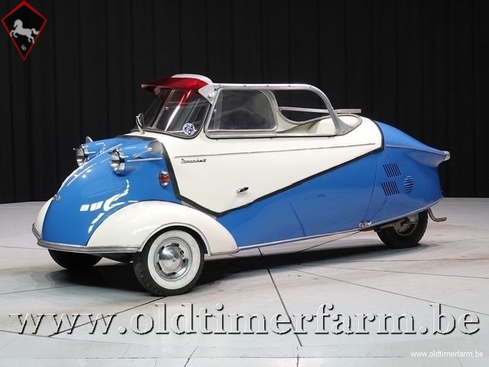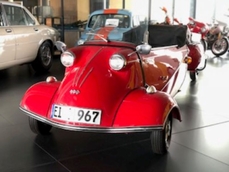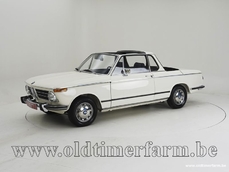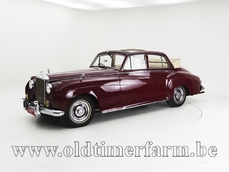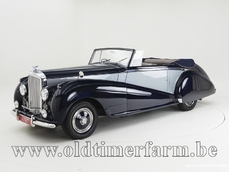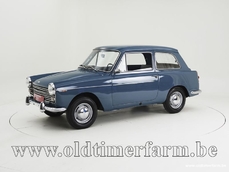Messerschmitt KR 200 1959
General description :
Messerschmitt KR 175 and KR 200 Kabinenroller are two-seater tricycles located one behind the other. The design of this extraordinary cart is due to the engineer Fritz Fend under the name of Messerschmitt KR175, then KR200: KR means Kabinenroller (cabin scooter), 175 and 200 mean cubic capacity. The idea of such a vehicle was to facilitate travel for all the disabled victims of the Second World War. The first series of Messerchmitt vehicles, called Flitzer, was equipped with a 38cc engine, the steering was operated by a broomstick. The two front tires were bicycle tires, soon replaced by wheelbarrow tires, except the rear wheel. The interior was protected by a transparent bubble, which could be removed in good weather. In 1953, at the Geneva Motor Show, the KR 175 was introduced for the first time. Its price was reasonable, and the production was 90 vehicles a day. The engine was a two-stroke Sachs motorcycle, endowed in 1954 with a special kind of reversing: to pass it, it is necessary to stop the engine. In the spring of 1955, the KR 200 appeared with a displacement of 192 cc. Sales in that year reached 12,000 vehicles. The KR 200 was available in a covered and convertible version from 1957. Gradually, sales of this atypical vehicle decreased especially because of the new boom of the German industry, which would allow the less privileged citizens to be able to buy safer and more spacious cars, like the VW Cox. Exports were also becoming increasingly rare, especially because of small vehicles such as the Mini that will be the coup de grace. Production stopped in 1964. Specifications Bodywork Length : cm (in): 282 (111) Width : cm (in): 122 (48) Height : cm (in): 120 (47) Wheelbase : cm (in) : 203 (80) Weight: kg (lb) : 230 (507) Mechanics. Displacement : one cylinder 192 cc, rear-mounted Valve gear : -- Fuel system : caruburettor Gearbox : 4-speed manual Drive wheels : rear-wheel drive Maximum power : 10 hp at 5250 rpm Maximum torque : 15 Nm at 3800 rpm Top speed : 90 km/h (57 mph)
http://www.oldtimerfarm.be/en/collection-cars-for-sale/4740/messerschmitt-kr-200-59.php
1959 Messerschmitt KR 200 is listed sold on ClassicDigest in Aalter by Oldtimerfarm Dealer for €31950.
Car Facts
Car type : Car Make : Messerschmitt Model : KR 200 Engine size : 0.0 Model Year : 1959 Sub type : Convertible Color : White Location : Aalter
Sold
Seller Information
Sold
People who viewed this Messerschmitt KR 200 also viewed similar Messerschmitt listed at ClassicDigest
Other cars listed for sale by this dealer
About Messerschmitt
The transition from manufacturing fighter aircraft like the BF109 to producing three-wheeled bubble cars is a fascinating chapter in the history of the German company Messerschmitt. After World War II, with the restrictions on Germany's ability to produce traditional aircraft, companies involved in aviation had to find alternative ways to survive. Messerschmitt, led by Willy Messerschmitt, was no exception.Transition to Bubble Cars:
Post-War Restrictions:
After Germany's defeat in World War II, the country faced severe restrictions on military production. Companies involved in wartime aircraft manufacturing had to diversify their production to survive.
Messerschmitt Company Background:
Messerschmitt, known for its wartime aircraft, including the famous BF109 fighter, was initially prohibited from producing aircraft. Willy Messerschmitt, the founder, faced challenges in maintaining his company's relevance.
Microcar Concept:
In 1952, Messerschmitt collaborated with engineer Fritz Fend to produce small, economical vehicles known as microcars. These vehicles were designed to meet the demand for affordable transportation in post-war Germany.
Messerschmitt Kabinenroller (Cabin Scooter):
The first microcar produced by Messerschmitt was the Kabinenroller (Cabin Scooter), introduced in 1953. It was a three-wheeled, tandem-seated vehicle with a distinctive bubble-shaped canopy. The driver sat in the front, and the passenger sat behind.
Success of the Kabinenroller:
The Messerschmitt Kabinenroller gained popularity for its unique design and fuel efficiency. It became one of the most iconic microcars of its time.
Variants and Models:
Messerschmitt produced several variants of the Kabinenroller, including the KR175 and KR200 models. These microcars featured a narrow track, lightweight construction, and a clear bubble canopy. They were powered by small displacement engines, often motorcycle engines.
Tandem Seating and Canopy:
The tandem seating arrangement and the distinctive bubble canopy were characteristic features of Messerschmitt microcars. The bubble canopy hinged forward for entry and exit.
Market Impact:
Messerschmitt microcars were well-received in the market, especially in the context of post-war fuel shortages and economic constraints. They became a symbol of practical transportation for the masses.
End of Production:
Messerschmitt continued to produce microcars until 1964. Changes in market demands, increasing competition, and the availability of more conventional small cars contributed to the end of the Kabinenroller's production.
The transition from manufacturing fighter planes to microcars by Messerschmitt reflects the adaptability of industrial companies in post-war Europe. The Kabinenroller microcars, with their distinctive design, remain an intriguing part of automotive history.
